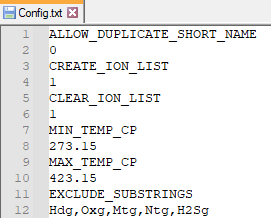Template:TPS Utility Config
Jump to navigation
Jump to search
-
- INCLUDE_ELEMENTS: specify in the line below this keyword the elements you want to include, comma separated list.
- EXCLUDE_ELEMENTS: specify in the line below this keyword the elements you want to exclude, comma separated list.
- INCLUDE_OCCURRENCES: specify in the line below this keyword the occurrences you want to include, comma separated list. Can be s, l, or g.
- INCLUDE_PHASES: specify in the line below this keyword the phases you want to include, comma separated list. These are substrings, thus, in the example above, any phase which contains slag (case insensitive) would be included.
- EXCLUDE_SUBSTRINGS: specify in the line below this keyword any substrings within species that you want to exclude, comma separated list. For example, entering C2, C3, C4 (case sensitive) would exclude ethyl, propyl, and butyl species.
- ALLOW_DUPLICATE_SHORT_NAME: specify in the line below this keyword either 0 (false) or 1 (true). If you allow duplicate short names, the short names will be appended with _1, then _2, etc. For example, if you have multiple types of silica, you would get SiO2, SiO2_1, SiO2_2, etc.
- CREATE_DEFAULT_SPECIES_IF_NO_MATCHES_FOUND: specify in the line below this keyword either 0 (false) or 1 (true). If you allow default species to be created, you will get default species (with no thermodynamic or properties data) as placeholders when a matching species is not found. If false, only matched species will be added to the database (with thermodynamic and properties data taken from the db3 file). Default value is true.
- MIN_TEMP_CP: specify in the line below this keyword the desired lower bound temperature of the heat capacity correlation for selection, in K. The utility will use this if, in the selection of the database, you choose -1. It will then find the matching database entry with the greatest Cp range within the desired range.
- MAX_TEMP_CP: specify in the line below this keyword the desired upper bound temperature of the heat capacity correlation for selection, in K. The utility will use this if, in the selection of the database, you choose -1. It will then find the matching database entry with the greatest Cp range within the desired range.
- Example for Cp Range: Consider where MIN_TEMP_CP is 273 K and MAX_TEMP_CP is 423 K. There are two possible species matching, one with a range of Range(K,273,450), and another with a Range (K,500,1500). Even though the second has a greater Cp Range than the first, its range is fully outside of the desired range, and thus, it will be rejected in favour of the first, which has a smaller range, but its range fully encompasses the desired range defined by MIN_TEMP_CP and MAX_TEMP_CP. Selections by this method are logged in the ErrorLog.txt file.
- USE_HARDWIRED_DATA: specify in the line below a value of 1 (true) or 0 (false). If true, it will use "hardwired" data from SysCAD and some additional data from NBS Tables when no data is available for a specific property and species.
- If no Config.txt file exists, all species are loaded unfiltered.
- If no Config.txt file exists, all species are loaded unfiltered.
-
